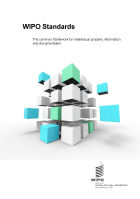WIPO Standards provide a framework for working with information in intellectual property documents.
- Covers patents, trademarks, industrial designs, geographical indications, and copyright
- Used for all stages of prosecution (filing, examination, publication, grant, etc.)
- Makes data machine readable for digital applications
Using WIPO Standards helps intellectual property offices around the globe work in a more efficient, harmonious, and timely fashion.
WIPO Standards also greatly simplify both international cooperation among offices and use by the public of intellectual property information.


